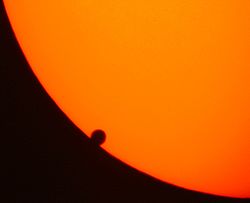Astronomical unit
The astronomical unit (AU) is a unit of length derived from the Earth's orbit. It is the average distance the Earth gets from the Sun on the long axis of the ellipse. Its definition is: the length of the semi-major axis of the Earth's elliptical orbit around the Sun. Semi-major means half the long axis.
| Standard: | Astronomical system of units (Accepted for use with the SI) |
| Quantity: | length |
| Symbol: | au, ua, or AU |
| Expressed in: | 1 au, ua, or AU = |
| metric (SI) units | 149597870700 m |
| imperial & US units | 9.2956×107 mi |
| astronomical units | 4.8481×10−6 pc 1.5813×10−5 ly |
The AU is about 150 million kilometers or 93 million miles. Astronomers usually measure distances within the Solar System in astronomical units. Mars is about 1.4 AU from the Sun, Jupiter lies at roughly 5.2 AU, and Neptune is roughly 30 AU from the Sun. Light travels an AU in about 8.317 minutes.
More accuracy
From 1976 to 2012 the AU was defined as "the radius of an unperturbed circular Newtonian orbit about the Sun of a particle having infinitesimal mass, moving with a mean motion of 0.01720209895 radians per day (known as the Gaussian constant)". [1][2][3] In 2012, the IAU redefined it to be the exact value 149597870700 m.[4][better source needed]
In the IERS numerical standards, the speed of light in a vacuum is defined as c0 = 299792458 m/s, in accordance with the SI units. The time to cover an AU is τA = 499.0047838061±0.00000001 s, resulting in the astronomical unit in metres as c0τA = 149597870700±3 m.[5] It is very roughly the distance from the Earth to the Sun.[better source needed]
Astronomical Unit Media
Transits of Venus across the face of the Sun were, for a long time, the best method of measuring the astronomical unit, despite the difficulties (here, the so-called "black drop effect") and the rarity of observations.
The astronomical unit is used as the baseline of the triangle to measure stellar parallaxes (distances in the image are not to scale)
References
- ↑ Resolution No. 10 of the XVIth General Assembly of the International Astronomical Union Archived 2019-05-02 at the Wayback Machine, Grenoble, 1976
- ↑ H. Hussmann, F. Sohl, J. Oberst (2009), "§4.2.2.1.3: Astronomical units", in Joachim E Trümper (ed.), Astronomy, astrophysics, and cosmology. Volume VI/4B Solar System, Springer, p. 4, ISBN 978-3-540-88054-7
{{citation}}: CS1 maint: multiple names: authors list (link) - ↑ Gareth V Williams (1997), "Astronomical unit", in James H. Shirley, Rhodes Whitmore Fairbridge (ed.), Encyclopedia of planetary sciences, Springer, p. 48, ISBN 0-412-06951-2
- ↑ Geoff Brumfiel (14 September 2012). "The astronomical unit gets fixed: Earth–Sun distance changes from slippery equation to single number". Nature. doi:10.1038/nature.2012.11416. S2CID 123424704. Retrieved 14 September 2012.
- ↑ Gérard Petit; Brian Luzum (2010). "Table 1.1: IERS numerical standards" (PDF). IERS technical note no. 36: General definitions and numerical standards. International Earth Rotation and Reference Systems Service. For complete document see Gérard Petit; Brian Luzum (2010). IERS Conventions (2010): IERS technical note no. 36. International Earth Rotation and Reference Systems Service. ISBN 978-3-89888-989-6. Archived from the original on 2019-06-30. Retrieved 2013-03-26.

